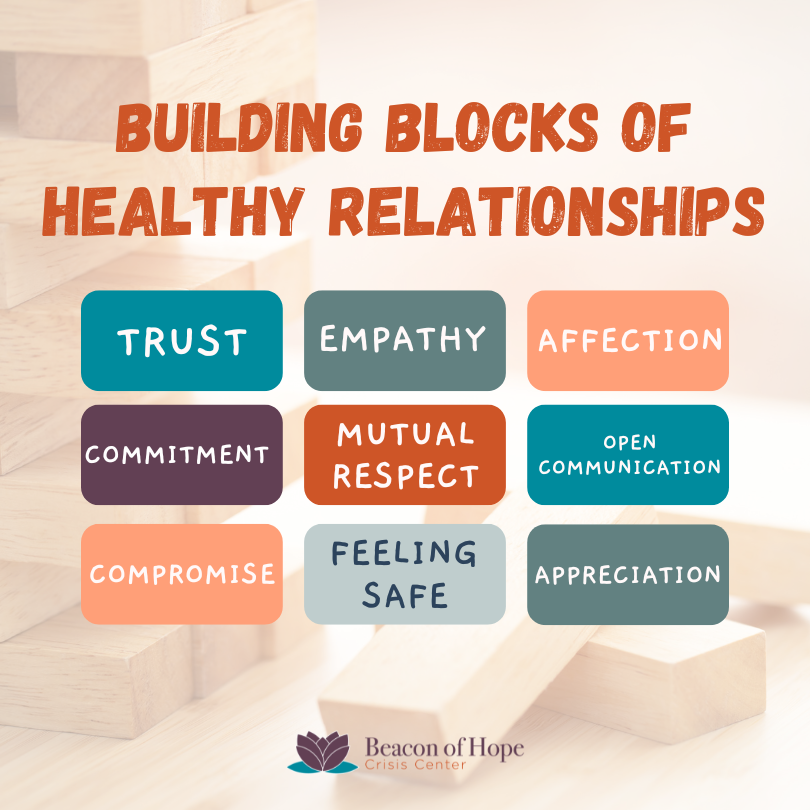The overarching goal of this program is to support the healthy development of youth and young adults by reducing their risk of continued and/or subsequent victimization in dating abuse relationships.
What Does Respect Look Like?
- Be polite (aware of non verbal cues and body language)
– Treat others with kindness – Listen before responding – Avoid negativity – Let go of anger – Be open to change - Value other’s opinions and feelings (practice compassion/empathy) – Talk to people, not about them – When you disagree, explain why you feel that way |
Prevention
The CDC recommends the following approaches to help prevent dating violence from occurring.
- Teaching safe and healthy relationship skills. Teach youth how to communicate and how to manage their feelings. As well as teaching them the characteristics of a healthy and unhealthy relationship.
- Engaging influential adults and peers. Participate in bystander empowerment and education opportunities, family based programs, and programs including men and boys as allies in prevention.
- Disrupting the developmental pathways toward partner violence. Encourage family engagement with schools, join groups to work on parenting skills and family relationships, and utilize resources for at-risk children, youth, and families.
- Creating protective environments. Work to improve the school climate and safety, improving organizational policies and workplace climate, and/or modifying the physical and social environments of neighborhoods.
- Strengthening economic support for families. Strengthen household financial security and the work-family supports available in the community.
- Supporting survivors to increase safety and lessen harm. Connect with survivor-centered services and programs for survivors of domestic violence, dating violence, and sexual assault. Learn more about housing programs, protection orders, safety planning, and more by speaking with a client specialist.
- Engaging influential adults and peers. Participate in bystander empowerment and education opportunities, family based programs, and programs including men and boys as allies in prevention.
- Disrupting the developmental pathways toward partner violence. Encourage family engagement with schools, join groups to work on parenting skills and family relationships, and utilize resources for at-risk children, youth, and families.
- Creating protective environments. Work to improve the school climate and safety, improving organizational policies and workplace climate, and/or modifying the physical and social environments of neighborhoods.
- Strengthening economic support for families. Strengthen household financial security and the work-family supports available in the community.
- Supporting survivors to increase safety and lessen harm. Connect with survivor-centered services and programs for survivors of domestic violence, dating violence, and sexual assault. Learn more about housing programs, protection orders, safety planning, and more by speaking with a client specialist.
|
Dating abuse is defined as - a pattern of behavior where one person uses threats of, or actually uses physical, sexual, verbal, or emotional abuse to control his or her dating partner.
What can abuse look like?
|
Impact of Dating Violence
|
Technology and Dating Abuse
- Catfishing: Done through accounts where someone is lying about their identity or posting as if they were someone else (often used to initiate a sexual or romantic relationship with the client)
- Cyberbullying: Repeated harassment or intimidation online; this might include threats and can escalate quickly (especially for teens and young adults)
- Cyberstalking: Monitoring someone’s location through GPS, social media, hacking their accounts, or otherwise installing spyware or location devices
- Trolling: Deliberately posting upsetting statements, comments, or photos to provoke a response
- Hacking into someone’s social media or email accounts
- Unsolicited sharing of pornographic or explicit images
Parents of Young Adults
Among high school students who dated, approximately 21% experienced physical and/or sexual dating violence.
Unfortunately, only 33% of teens who have been in or are aware of an abusive dating relationship report telling anyone about it. Parents are often unaware that their teens are suffering from dating abuse. Though 82% of parents feel confident that they could recognize the signs if their child was experiencing dating abuse, a majority of parents (58%) could not correctly identify all of the warning signs of abuse.
Among adult survivors of rape, physical violence, and/or stalking by an intimate partner, 15-22% of young adults first experienced some form of partner violence between 11 and 17 years of age.
Dating violence can have a negative effect on health throughout life. Youth who are impacted are more likely to experience symptoms of depression and anxiety, engage in unhealthy behaviors, like using tobacco, drugs, and alcohol, or exhibit antisocial behaviors and think about suicide.
Beacon of Hope Crisis Center, a leader in prevention and outreach services for domestic violence survivors and their children, recognizes the growing need to address young adult dating violence in Indiana.
Unfortunately, only 33% of teens who have been in or are aware of an abusive dating relationship report telling anyone about it. Parents are often unaware that their teens are suffering from dating abuse. Though 82% of parents feel confident that they could recognize the signs if their child was experiencing dating abuse, a majority of parents (58%) could not correctly identify all of the warning signs of abuse.
Among adult survivors of rape, physical violence, and/or stalking by an intimate partner, 15-22% of young adults first experienced some form of partner violence between 11 and 17 years of age.
Dating violence can have a negative effect on health throughout life. Youth who are impacted are more likely to experience symptoms of depression and anxiety, engage in unhealthy behaviors, like using tobacco, drugs, and alcohol, or exhibit antisocial behaviors and think about suicide.
Beacon of Hope Crisis Center, a leader in prevention and outreach services for domestic violence survivors and their children, recognizes the growing need to address young adult dating violence in Indiana.
|





